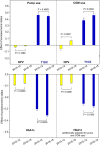A Decade of Disparities in Diabetes Technology Use and HbA1c in Pediatric Type 1 Diabetes: A Transatlantic Comparison
- PMID: 32938745
- PMCID: PMC8162452
- DOI: 10.2337/dc20-0257
A Decade of Disparities in Diabetes Technology Use and HbA1c in Pediatric Type 1 Diabetes: A Transatlantic Comparison
Abstract
Objective: As diabetes technology use in youth increases worldwide, inequalities in access may exacerbate disparities in hemoglobin A1c (HbA1c). We hypothesized that an increasing gap in diabetes technology use by socioeconomic status (SES) would be associated with increased HbA1c disparities.
Research design and methods: Participants aged <18 years with diabetes duration ≥1 year in the Type 1 Diabetes Exchange (T1DX, U.S., n = 16,457) and Diabetes Prospective Follow-up (DPV, Germany, n = 39,836) registries were categorized into lowest (Q1) to highest (Q5) SES quintiles. Multiple regression analyses compared the relationship of SES quintiles with diabetes technology use and HbA1c from 2010-2012 to 2016-2018.
Results: HbA1c was higher in participants with lower SES (in 2010-2012 and 2016-2018, respectively: 8.0% and 7.8% in Q1 and 7.6% and 7.5% in Q5 for DPV; 9.0% and 9.3% in Q1 and 7.8% and 8.0% in Q5 for T1DX). For DPV, the association between SES and HbA1c did not change between the two time periods, whereas for T1DX, disparities in HbA1c by SES increased significantly (P < 0.001). After adjusting for technology use, results for DPV did not change, whereas the increase in T1DX was no longer significant.
Conclusions: Although causal conclusions cannot be drawn, diabetes technology use is lowest and HbA1c is highest in those of the lowest SES quintile in the T1DX, and this difference for HbA1c broadened in the past decade. Associations of SES with technology use and HbA1c were weaker in the DPV registry.
© 2020 by the American Diabetes Association.
Figures


Comment in
-
Racial and Socioeconomic Disparities in Pediatric Type 1 Diabetes: Time for a Paradigm Shift in Approach.Diabetes Care. 2021 Jan;44(1):14-16. doi: 10.2337/dci20-0048. Diabetes Care. 2021. PMID: 33444165 No abstract available.
References
-
- Miller KM, Hermann J, Foster N, et al.; T1D Exchange and DPV Registries . Longitudinal changes in continuous glucose monitoring use among individuals with type 1 diabetes: international comparison in the German and Austrian DPV and U.S. T1D Exchange registries. Diabetes Care 2020;43:e1–e2 - PMC - PubMed
-
- American Diabetes Association . 13. Children and adolescents: Standards of Medical Care in Diabetes—2019. Diabetes Care 2019;42(Suppl. 1):S148–S164 - PubMed
-
- American Diabetes Association . 7. Diabetes technology: Standards of Medical Care in Diabetes—2019. Diabetes Care 2019;42(Suppl. 1):S71–S80 - PubMed
Publication types
MeSH terms
Substances
Associated data
Grants and funding
LinkOut - more resources
Full Text Sources
Medical
Research Materials
Miscellaneous

